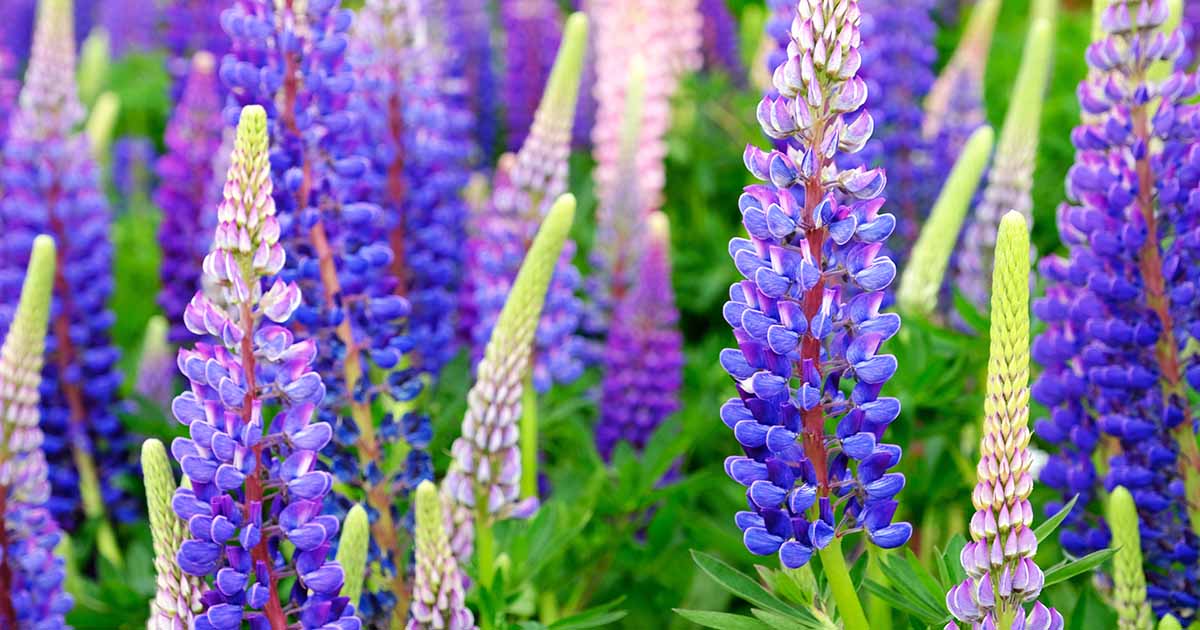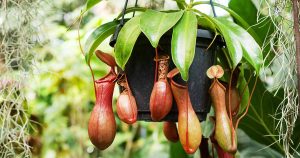
Lupinus spp.
The first time I saw lupines I was riding a train in Sweden. The tall flower stalks were in full bloom and covered the fields everywhere we went.
They grew along the tracks, in abandoned lots, and lining the rolling hills.
Of course, I’d seen them on TV and in gardening books, and they always seemed so enchanting – but in reality they were even more impressive than I expected.

We link to vendors to help you find relevant products. If you buy from one of our links, we may earn a commission.
Lupines aren’t just striking, they are generous as well. Not only do they give us tall spires of color, but they can grow as wildflowers with little maintenance. And as legumes, instead of taking nitrogen out of the soil, they give it back.
On top of all that, once you have them in the ground, they keep returning year after year with spires of color.
These plants come in more shapes, sizes, and colors than many gardeners realize, from petite purple bloomers to tall, packed spikes of bright pink or yellow flowers.
Whether you’re dreaming of a garden full of Russell hybrids or a sweet little native species to add color to your wildflower garden, you’ve got plenty of options.
Here’s what we are going to discuss in this guide:
Let’s all get on the same page about exactly what lupines are, first.
What Are Lupines?
Lupines are plants in the Lupinus genus, part of the same family – Fabaceae – as peas and other legumes. Most are short-lived perennials but some are annuals.

Sometimes called “lupins,” they all look pretty distinctive, with their palm-like foliage and spikes of purple or sometimes yellow or white flowers.
Species plants and those growing wild produce purple, white, or yellow flowers, or a combination of those colors.
Cultivated varieties increase the color palette to include shades of blue, gold, yellow, white, pink, purple, lavender, red, and burgundy.
There are rare mutations found in the wild of pink, red, or other colors, but don’t count on these appearing if you grow species plants. Just consider them a bonus if they do.
Depending on the species, the flowers appear in the spring or summer and can persist for weeks. Each individual flower can resemble the bonnet of a cape, which is why they’re sometimes called bluebonnets.

The plants themselves can range from under a foot tall, like sweet prairie lupine (L. lepidus) or up to almost six feet tall, like Big Bend bluebonnet (L. havardii).
Most are herbaceous plants, but some, like riverbank lupines (L. rivularis) and tree lupines (L. arboreus) can have a woody, shrubby growth habit.
In most commonly cultivated types, the stems grow from a branching taproot with nodules that enable it to fix nitrogen in the soil. There can be one or more stems growing out of the crown.

The leaves are palmately compound. That’s fancy botany-speak to describe leaves that have the shape of a hand. Each leaf has between five and 28 “fingers,” which are called leaflets, depending on the species.
These are held on long stems called petioles that can be a foot long or more. Go outside after a rainstorm and look at the leaves. Droplets gather at the center and look like little jewels.

The spires are made up of flowers that look like large pea blossoms. Each flower has five large and five small stamens and is attached to the main stem by a small stalk.
Once the flowers fade, fuzzy seed pods form in their place. The seeds inside have a tough shell that can keep them fresh for years, so there’s no rush to sow them.

Most North American lupines are native to the west coast and thrive in Zones 4 to 8.
These include the bigleaf (L. polyphyllus), broadleaf (L. latifolius), harlequin (L. stiversii), golden (L. densiflorus), prairie, sky (L. nanus), and summer (L. formosus) lupines.
There are several species that appear outside of this range, though. East of the Rockies, you’ll find Big Bend bluebonnet, Sundial (L. perennis), Texas bluebonnet (L. subcarnosus), Nebraska (L. plattensis), and spreading (L. diffusus) lupine.
Broadleaf lupines have snuck out of gardens in the Pacific Northwest and spread into wild areas. They are taking over the native species in places like Maine, so many of the eastern species have become much less common in the wild than they used to be.
L. latifolus has also started spreading in parts of Europe. Those lupines I admired along the rail line in Sweden? They were likely broadleaf types.
If you’ve ever visited the annual lupine festival in Sugar Hill, New Hampshire, you were actually celebrating the presence of broadleaf lupines that have taken over where native species would have once grown.

There are also species native to the Mediterranean, South America, Europe, and Africa. Narrow-leaf (L. angustifolius), European yellow (L. luteus), and wolf bean (L. albus) are all common in cultivation.
Native lupines are almost all various shades of purple, though they might have touches of white and yellow. Hybrids, on the other hand, are where you find the brighter reds, golds, and pinks.

If you live in North America, I urge you to choose species that are indigenous to your region.
The hybrids might have showier spires, but they crowd out native species and they aren’t the preferred food source of native bees and other pollinators.
Native caterpillars can’t feed and pupate on the introduced species like they can on natives, which leads to reduced butterfly populations.
I’m not against planting some of the showy hybrids, but if you want to go with one of the wildflower types, choose something native to your area.
In some countries, like New Zealand, non-native lupines are considered invasive.
Another word of warning:
Lupine plants contain alkaloids such as anagyrine, hydroxylupanine, lupinine, and sparteine. These are concentrated in the seeds and can be toxic in large quantities.
You should keep the plant out of forage areas where horses, cattle, and sheep may feed.
Of course, you shouldn’t eat any part of the plant, either, unless you are absolutely sure you are growing an edible type like L. albus.
Cultivation and History
Ancient Incans and Romans, along with Native Americans have all used lupine seeds as edible beans similar to soybeans. In some areas, the beans are still considered a treat.
European white or wolf bean (L. albus) is cultivated for the beans and is a popular food in parts of Europe, Egypt, and Brazil.
Until the early 1900s, lupines were mostly wildflowers until the horticulturalist George Russell of York, England started work hybridizing L. polyphyllus to create larger and more colorful flowers. In 1937, at the age of 79, Russell exhibited his new creations at the Chelsea Flower Show.
He won numerous prestigious awards for his efforts, and they’ve become far and away the most popular types to grow in the home garden.
There are also newer cultivars like those in the Tutti Frutti series, which feature tall flower spikes in bold colors.
Those in the Minarette series come in dwarf sizes under 20 inches tall, and plants from the Gallery series are under two feet tall.
Lupine Propagation
Lupines are best propagated via seeds or basal cuttings. You can also purchase plants from the nursery for transplanting.
It’s best not to try and divide existing plants. Why, I hear you ask? These plants don’t enjoy being transplanted and they really don’t divide well.
If you try to divide existing plants the likelihood is you’ll end up killing the plant. If you’re experienced with plant division, feel free to give it a try. Otherwise, stick to the more reliable options.
From Seed
Any of the big, showy hybrids can be grown from purchased seeds, but if you save seeds from the plants themselves, they will start to revert back to their original bigleaf lupine form and will not grow true.
If you intend to start the seeds indoors and move the seedlings outside, use biodegradable pots to reduce transplant shock. The long taproots are sensitive and they don’t like being disturbed.

Start the seeds indoors six to eight weeks before the last predicted frost date in your area or outdoors as soon as the soil can be worked in spring.
The seeds need to be stratified and scarified before sowing. Alternatively, you can plant them outdoors in the fall and let nature do the stratification work for you.
To stratify the seeds, put them in moist sand or sphagnum moss in a sealable bag or container and stick them in the refrigerator. Keep the medium moist and leave them in place for three months.
Remove the seeds from the fridge and nick the hard coating with nail clippers or sand the shell down with a metal nail file. Optionally, soak them in warm water for a few hours before planting to improve germination.
Fill your pots with a seed-starting or general purpose potting medium. As mentioned, it’s best to use compostable pots because they cause less trauma to the developing taproot than removing the seedling from its container during transplanting.
Any compostable container will do, but I always use CowPots because they’re made using a renewable resource, namely cow poop!
Something like these #4 tall planters would be ideal because they have lots of room for the lupine root to develop.
You can purchase 144 or 300 pots at Arbico Organics.
Once you have your filled container, press each seed into the soil so it’s buried as deep as it is long.
Keep the soil consistently moist and wait for the magic to happen. Keep in mind that if you use compostable pots, they tend to dry out more quickly than conventional ones, so make sure you check them regularly and water as needed.
Once the seedlings emerge, place the pots under grow lights or in a window that receives about six hours of direct sunlight.
Continue to provide even moisture. When the seedlings are about three inches tall, harden them off for a week and then plant them in the garden.
Hardening off is the process of gradually introducing a plant that has been growing in the relatively protected conditions indoors to the more harsh environment of the outdoors.
To do this, bring the plant outside and set it in a protected but sunny spot for an hour. Take it back inside for the rest of the day.
The next day, leave it out for two hours, and then three hours on the following day. Do this for seven days and your seedlings will be much less likely to suffer any shock from the transplanting process.
From Cuttings
Seeds are the more reliable way to propagate these plants, but it’s also possible to grow lupines from cuttings. This is also the best method if you want to replicate a plant that you love, since starting from saved seed doesn’t guarantee an exact replica, but a cutting creates a clone.
In the early spring, before blooming begins, grab a clean pair of clippers, a knife, or some scissors, and a glass of water and head out into the garden or wilderness area. Just be sure its legal to gather plant parts wherever you decide to go.
Lupines can be propagated from basal cuttings, not stem cuttings. You might have guessed from the name, but this means that you are going to take the cutting right from the base of the plant.
I like to use a craft knife or a mushroom harvesting knife to take basal cuttings, but anything sharp and precise is fine. Wipe your chosen tool with isopropyl alcohol or a 10 percent bleach solution prior to starting work.
Examine the base of the plant and find a spot where the stems are growing in a cluster. Typically, you will find several stems clustered together in their own little grouping.
Gently cut away one of these groupings, cutting down through the natural division in the crown next to the stem group and into the soil.
Remove all but one or two leaves. You only want one or two leaves on each basal cutting so the existing material can use its resources to develop new growth rather than wasting energy on supporting a lot of foliage.
Place the cutting in your glass of water so just the base is covered and gather the rest of your cuttings.
Next, fill four-inch pots with a seed-starting medium, one container for each cutting. Poke a hole in the middle of each pot. If the cuttings are quite small, you may be able to squeeze two or three into a pot. Stick a cutting in each hole and firm the soil up around it.
Moisten the soil and place a glass cloche or clear plastic over the top of each pot. Prop it up with a chopstick or pencil, if necessary, because you don’t want the plastic touching the plant material.
Place the cuttings in an area with bright, indirect sunlight and keep the soil moist but not soaking wet until the cutting develops roots. If you don’t see any condensation on the inside of the cover, spritz the interior with a spray bottle to increase the humidity.
After a few weeks, roots should have started forming. You can dig your finger down into the soil and gently feel around to see if they’re present.
So long as the upper part of the cutting looks turgid and fungus-free, you can be patient while they develop.
Once new growth pops out of the ground, harden the plant off for a week and move it into full sunlight. Then, plant in the ground.
Transplanting
I have transplanted lupines, and it can be done, but I do lose one or two now and then. I’ve even lost a few potted plants that I moved into the ground.
It’s especially risky if you’re working with a plant that has been growing in its container for a long time.

Lupines have long taproots and to transplant them successfully, you need to dig up most of the root, and even then the process might still shock the plant. You can even shock a potted plant if you aren’t extremely careful when you’re working with it.
To plant a potted lupine, prep the soil by working in some well-rotted compost unless your soil is already nice and loamy. Of course, if you’re working with a species that prefers sandier or heavier soil, you can skip this step.
Dig a hole about twice as wide as the growing pot and about the same depth. Carefully cut away the growing container if the seedling or plant is in a grower’s pot.
Gently lower the plant into the hole and backfill with the removed soil. If it is in a biodegradable pot, lower the container into the soil. Firm the soil around the plant and water in well.
If the soil settles, add more. You want the base of the stems where they grow together to be just above the soil.
How to Grow Lupines
Most lupines like full sun, though they can tolerate some afternoon shade. But just because they need lots of light, that doesn’t mean they thrive in excessively hot conditions.
Most prefer cool climates in Zones 3 to 9. If you live somewhere hot and dry, look for the species that are native to your area.

You can also use a thick layer of organic mulch, like well-rotted compost, leaves, or bark to help keep the soil around the root zone a bit cooler.
Species indigenous to eastern North America and California tend to prefer dry, sandy soil, while those from the Pacific Northwest like more loamy – but not too rich – soil that is consistently moist. The common hybrids need organically-rich, loamy soil.
All prefer slightly acidic to acidic, well-draining soil with a pH of 5.5 to 6.5.
The flowers rarely appear the first year you put them in the ground, but the plants should start flowering the following year.

The amount of water lupines need depends entirely on the species you are growing.
For example, bigleaf lupine prefers soil that is consistently moist but not soggy during the spring, fall, and winter, and dry soil during the summer.
There’s no need to water these plants during the summer or winter, but add water when the top one or two inches of soil is dry during the spring and fall.
The common hybrids should be watered when the top three inches of soil have dried out. Don’t water them at all during the winter.
You don’t need to fertilize lupines. They fix nitrogen and most thrive in depleted soil. After a fire tears through an area, lupines are often one of the first plant species to pop up.
When Mount St. Helens in Washington exploded in 1980, lupines filled the impacted areas afterwards.
You can grow lupines in pots. Even the tall ones do well in containers, so long as it’s large enough to support their expected mature size.
These plants aren’t particularly top-heavy, so a deep pot that has about a foot of depth for the taproot to grow in is perfectly sufficient.
Consider growing some marigolds, columbine, violets, small sunflowers, or coneflowers in the container with the lupines so you have some extended-season interest.
Growing Tips
- Grow in full sun or partial sun.
- Ensure that the soil is well draining with a pH of 5.5 to 6.5.
- Keep soil evenly moist, depending on the species you are growing.
Maintenance
With some species and the popular hybrids, if you cut back the flower spikes when the flowers fade, the plant may produce a second flush of smaller blossoms.

Lupines fade after blooming and die back completely during the winter.
Once the foliage and flower stalks have collapsed and turned brown, cut them off the plant to avoid providing a spot for pests and diseases to flourish.
Otherwise, lupines are the definition of maintenance-free.
Species and Cultivars to Select
The Russell hybrids are the most popular cultivars out there, but many other plant breeders have cultivated interesting and beautiful options.
Of course, many of the species plants make wonderful landscape options, as well.
Here are some of the showier and more versatile types.
Bigleaf
Bigleaf lupines (L. polyphyllus) grow natively in the Pacific Northwest, but they’ve spread all the way to the Atlantic Coast, Europe, and New Zealand.

Gardeners can’t resist planting this beauty, and I certainly can’t blame them. But this adaptable plant can be a little too good at reproducing itself.
So long as it doesn’t become invasive in your area, it’s a tough and reliable option for Zones 4 to 8, where you’ll be treated to five-foot-tall plants with tall spires of purple flowers.
Broadleaf
Broadleaf lupines (L. latifolus) can be found all along the Pacific Coast and as far east as New Mexico.

These bushy plants grow one to four feet tall and produce foot-long racemes covered in purple blossoms.
Broadleaf lupines thrive in dry areas with sandy soil and they spread readily via roots and seeds, so they’re perfect to fill an eroded or depleted section of the landscape.
Grow them in Zones 5 to 9.
Gallery Series
The Gallery series treats you to two-foot-tall spires of colorful flowers that shoot up in the spring and last through early summer – or even longer if you keep up with deadheading.
If you want a head start on the growing season, you can grab live plants in a blue hue in #1 containers at Nature Hills Nursery.
Nature Hills Nursery also carries Gallery red in #1 containers.
Pixie Dwarf Mix
Sunrise lupines (L. hartwegii) are an annual type, but they self-seed freely, so they’ll keep coming back if you let them.
L. hartwegii nanus is a dwarf variety that looks similar to the species, only smaller, remaining under a foot tall.
The flowers come in shades of pastel pink, dark purple, and rose. They will even bloom in partial shade.
You can find Pixie Dwarf Mix which contains a mix of colors available at Eden Brothers in a variety of packet sizes and in bulk.
Russell
The original hybrids created by George Russell feature flower stalks packed tight with vibrant purple, orange, pink, salmon, cream, and burgundy blossoms.
This stunner earned Russell the coveted Veitch Medal from the Royal Horticultural Society (RHS) in 1937.
In 1913, the RHS voted to name the Russell lupine as Top Plant released during the 1932 to 1942 period. It also snagged second place overall in the competition.
The plants grow up to 40 inches tall with little maintenance required to enjoy the blossoms from spring through summer.
Any lupine lover should have this one in their garden.
Make it happen by grabbing a packet, ounce, quarter pound, pound, or five-pound quantity of seeds at Eden Brothers.
Sundial
Unlike some of the more familiar hybrids, the flowers on the spikes of sundial or wild lupine (L. perennis) are loosely arranged, which gives them a beautiful wildflower look.
Each plant has numerous stalks and can grow up to 30 inches tall, with flowers from late spring and through summer.
Unlike some lupines, which need moist soil, this species can tolerate drought.
You can find sundial lupine seeds available at Eden Brothers in a variety of package sizes and in bulk.
Texas Bluebonnet
Growing wild in the hot climates of Texas, Oklahoma, and northern Mexico is the beautiful Texas bluebonnet (L. texensis).
This species is the state flower of Texas and it doesn’t mind heat and intense sun.
It’s an annual that readily self-seeds to give you year after year of foot-tall plants topped with indigo flower stalks.
If you’d like to bring this wildflower home, pop over to True Leaf Market where you can find seeds in a variety of packet sizes.
Managing Pests and Disease
Lupines are pretty problem-free. The usual herbivore culprits like deer and mice won’t trouble them and there are only a few insects or pathogens that regularly come calling.
I would personally grow these plants even if they were fussy and delicate, but they aren’t. Just add another tick in the plus column for lupines.
Insects
It’s possible that spider mites will feed on lupines, especially those growing in drier regions, but it’s not a common occurrence. More frequently, it’s aphids you’ll be dealing with.
Aphids
Aphids seem to just appear in droves overnight.
One day, your lupine is totally pest-free and then some sort of aphid call goes out and suddenly your plant is covered in the western American lupine aphid (Aphis lupini) or the lupine aphid (Macrosiphum albifrons).

These pests suck the sap out of the plant and leave behind a sticky residue known as honeydew.
This feeding can cause reduced vigor, yellowing foliage, as well as spread disease.
Lupine aphids can be dealt with in the same way as any other species. To learn about how to deal with aphids, read our guide.
Disease
There are two lupine diseases to keep an eye out for. The first is the common garden foe, powdery mildew, and the second is caused by a virus. Let’s talk about that, first.
Cucumber Mosaic Virus
Cucumber mosaic virus (CMV) and aphids go hand in hand. The sapsuckers carry the virus, spreading it from plant to plant.
Once infected, the plants turn pale and the growth is stunted. You’ll also see foliage curling. While a yellow mosaic pattern on the foliage is common in other species, in lupines, it tends to be faint.
Usually, the older leaves remain healthy-looking but newly emerging leaves will be symptomatic.
Seed production will be reduced and the pods will be smaller. Seeds can also be infected, and when they germinate, the seedlings will be severely stunted and will be symptomatic on all parts of the plant.
Sadly, there isn’t anything you can do to cure the infection. Pull any symptomatic plants and don’t save the seeds.
Powdery Mildew
The most common disease seen on lupines is powdery mildew.
It’s caused by the fungi Erysiphe polygonia, E. lupine, and E. intermedia, but regardless of the specific species, the symptoms all look the same.

The most obvious sign is circular, powdery grayish-white patches on the leaves and sometimes the stems and/or flowers.
As the disease progresses, you might also see black dots inside the white areas. The leaves can also turn yellow and may curl, dry up, and die.
The pathogen thrives in humid but dry conditions. Sounds contradictory, right? It loves humidity in the air but needs a dry plant surface on which to develop.
These days, experts recommend that you simply ignore the problem. Unless a majority of the leaves start to die back, just consider it a part of growing lupines.
If the problem is severe, read our guide to powdery mildew to learn how to control it. There are dozens of effective products out there from milk to fungicides.
Best Uses for Lupines
Few floral displays can match the drama of a vase full of lupine spikes, whether in bunches or mixed with other flowers and fillers.
Similarly, the plants make a colorful, eye-catching border in the garden. You can also grow lupines singly as a specimen or mixed with other species.

I think they look especially beautiful contrasted against rounder plants like roses or camellias.
The shorter species work well as flowering ground covers.
Lupines can also be grown as a cover crop in fallow garden beds as they fix nitrogen in the soil, giving you the perfect opportunity to enjoy the flowers en masse.
Quick Reference Growing Guide
| Plant Type: | Herbaceous or shrubby perennial or annual | Flower/Foliage Color: | White, pink, red, purple, lavender, yellow; green, green and cream |
| Native to: | Asia, Europe, North America | Maintenance: | Low |
| Hardiness (USDA Zones): | 3-9 | Tolerance | Some drought, some shade, poor soil |
| Bloom Time: | Spring | Soil Type: | Sandy, loamy, depleted |
| Exposure: | Full to partial sun | Soil pH: | 5.5-6.5 |
| Time to Maturity: | 1 year | Soil Drainage: | Well-draining |
| Spacing: | 6 inches or more, depending on species | Attracts: | Bees, birds, hummingbirds |
| Planting Depth: | Same depth as container (transplants), as deep as the length of the seed | Companion Planting: | Allium, aspen, aster, California poppy, camellias, ceanothus, columbine, coneflowers, marigolds, roses, sage, sunflowers, violets |
| Height: | Up to 8 feet | Uses: | Beds, borders, cover crop, cut flowers, ground cover, specimen |
| Spread: | 4 feet | Order: | Fabales |
| Growth Rate: | Fast | Family: | Fabaceae |
| Water Needs: | Moderate | Genus: | Lupinus |
| Common Pests and Diseases: | Aphids; Cucumber mosaic virus, powdery mildew | Species: | Albus, arboreus, angustifolius, densiflorus, diffusus, formosus, havardii, latifolius, lepidus, luteus, nanus, perennis, plattensis, polyphyllus, rivularis, stiversii, subcarnosus |
The Iconic Wildflower
What is it about lupines? The wild ones are perfectly magical and the cultivated varieties are even more incredible.

I don’t choose these flowers because they’re low-maintenance and add nitrogen to the soil. Those are just bonuses! But even if they were fussy and difficult, I’d still give lupines a spot in my garden.
What kind do you want to grow? Are you looking for something drought-tolerant and low-growing to fill up a dry area? Or are you eyeballing those stunning modern hybrids to add drama to a border? Let us know in the comments section below.
And for more information about growing flowering plants in your garden, you’re sure to enjoy these guides next:












